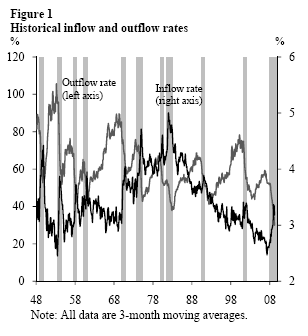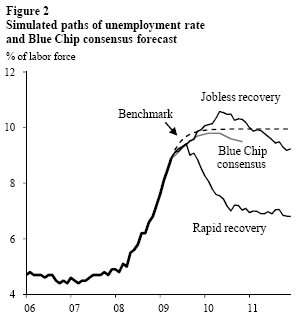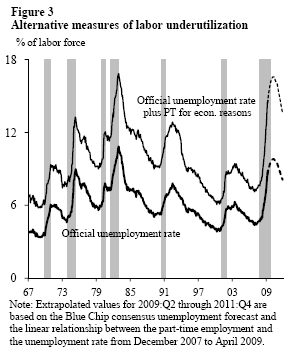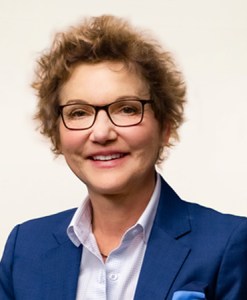Although the pace of layoffs appears to be subsiding and the overall economy is showing hints of stabilization, most forecasters expect unemployment to continue to increase in coming months and to recede only gradually as recovery takes hold. In this Economic Letter, we evaluate this projection using data on three labor market indicators: worker flows into and out of unemployment; involuntary part-time employment; and temporary layoffs.
Although the pace of layoffs appears to be subsiding and the overall economy is showing hints of stabilization, most forecasters expect unemployment to continue to increase in coming months and to recede only gradually as recovery takes hold. In this Economic Letter, we evaluate this projection using data on three labor market indicators: worker flows into and out of unemployment; involuntary part-time employment; and temporary layoffs. We pay particular attention to how these indicators compare with data from previous episodes of recession and recovery. Our analysis generally supports projections that labor market weakness will persist, but our findings offer a basis for even greater pessimism about the outlook for the labor market. Specifically, we suggest that the relatively low level of temporary layoffs and high level of involuntary part-time workers make a jobless recovery similar to the one experienced in 1992 a plausible scenario.
The U.S. labor market is always in flux as workers leave or find jobs and employers lay off or hire workers. The U.S. Bureau of Labor Statistics (BLS) tracks the results of all this churning, providing estimates of the number of people who are employed and unemployed each month. For the unemployed, the BLS also reports how long they have been searching for work, known as the duration of unemployment. All of these data are released as part of the monthly national employment report.
 Researchers have used these monthly counts to estimate the underlying movements of workers into and out of unemployment. Researchers typically focus on two rates: the inflow rate, or the pace at which workers move into unemployment, and the outflow rate, or the pace at which they move out of unemployment (see Shimer 2005). These flows into and out of unemployment provide information about the dynamics underlying the monthly labor market numbers. As such, they can be useful in gauging labor market weakness and strength around turning points in economic activity. Inflow and outflow rates tend to be cyclical, following ups and downs in the economy. During recessions, the inflow rate generally increases as people lose their jobs and become unemployed. At the same time, the outflow rate decreases, as the slowdown in the economy makes it harder for unemployed workers to find jobs. These cyclical inflow and outflow patterns are shown in Figure 1.
Researchers have used these monthly counts to estimate the underlying movements of workers into and out of unemployment. Researchers typically focus on two rates: the inflow rate, or the pace at which workers move into unemployment, and the outflow rate, or the pace at which they move out of unemployment (see Shimer 2005). These flows into and out of unemployment provide information about the dynamics underlying the monthly labor market numbers. As such, they can be useful in gauging labor market weakness and strength around turning points in economic activity. Inflow and outflow rates tend to be cyclical, following ups and downs in the economy. During recessions, the inflow rate generally increases as people lose their jobs and become unemployed. At the same time, the outflow rate decreases, as the slowdown in the economy makes it harder for unemployed workers to find jobs. These cyclical inflow and outflow patterns are shown in Figure 1.
Although the cyclicality in labor market flows is evident across all periods, the relationship between the movements of the two rates has varied over time. In the 1970s and 1980s, recessions were characterized by nearly equivalent relative increases in the inflow rate and declines in the outflow rate. This combined deterioration created large recessionary increases in unemployment. However, these sharp recessionary responses were followed by strong post-recession recoveries, in which the inflow and outflow rates returned to nonrecessionary patterns quickly, resulting in steep declines in the unemployment rate.
This behavior changed notably in the 1991 and 2001 recessions. In both episodes, the main factors behind rising unemployment rates were declines in the outflow rate, not increases in the inflow rate, as Figure 1 shows. In other words, lack of hiring rather than high rates of firing was key in boosting the unemployment rate. As the recessions passed and recoveries began, another divergence from history occurred. In contrast to the 1970s and 1980s, outflow rates moved back to their normal levels relatively slowly, creating the jobless recoveries that followed these two recessions. This dramatic change in the cyclical pattern of inflow and outflow rates was pointed out by Hall (2005) and Shimer (2005, 2007), both of whom showed that in the post-1980s economy, outflow rates account for the lion’s share of business cycle fluctuations in the unemployment rate.
During the current recession, both the inflow and outflow rates have shifted significantly, with high levels of firing and low levels of hiring, similar to what was observed in the 1970s and 1980s. We are currently at a historically low outflow rate, meaning that the unemployed find it very difficult to get work and average unemployment spells are getting much longer. At the same time, the recent increase in the inflow rate is comparable to what was observed in the 1970s and 1980s. These factors combined are creating especially weak labor market conditions.
The key question going forward is, what type of recovery lies ahead? Will the inflow and outflow rates experience the same snapback as in the 1970s and 1980s? Or will they retrace their prior paths only gradually, leading to subpar net hiring reminiscent of the recoveries from the 1991 and 2001 recessions? To address this question, we examine how different rates of outflow would affect the path of the unemployment rate.
 Before considering how assumptions about the pace of hiring in a recovery might affect unemployment forecasts, it is useful to see how unemployment would evolve if labor market conditions stayed just as they are today, getting no worse nor better. This benchmark calculation is plotted in Figure 2 as the dashed line. It shows that, if inflow and outflow rates were frozen at today’s values, the unemployment rate would plateau at around 10% in early 2010. As the nearby solid gray line indicates, this is roughly in line with the Blue Chip consensus forecast. Of course, in the Blue Chip forecast, the unemployment rate comes down over time, since the forecast anticipates improvements in labor market conditions due to an overall economic recovery.
Before considering how assumptions about the pace of hiring in a recovery might affect unemployment forecasts, it is useful to see how unemployment would evolve if labor market conditions stayed just as they are today, getting no worse nor better. This benchmark calculation is plotted in Figure 2 as the dashed line. It shows that, if inflow and outflow rates were frozen at today’s values, the unemployment rate would plateau at around 10% in early 2010. As the nearby solid gray line indicates, this is roughly in line with the Blue Chip consensus forecast. Of course, in the Blue Chip forecast, the unemployment rate comes down over time, since the forecast anticipates improvements in labor market conditions due to an overall economic recovery.
Next we consider the potential for the path of unemployment to diverge from benchmark and Blue Chip consensus forecasts. This exercise considers how the unemployment rate would evolve if the inflow and outflow rates behaved as they did in previous recoveries. We simulate two alternative recovery paths: the one traced in the 1982-1983 recession/recovery, which represents a rapid rebound, and the one in the 1991-1992 recession/recovery, which represents a jobless recovery. The simulation requires that we select a starting point, which is the point at which the inflow rate peaks. We choose December 2008 as our starting point.
As the figure shows, in each simulation, the unemployment rate continues to rise even as job losses slow and the inflow rate begins to decline. This pattern reflects the normal lag between the peak in the inflow rate and the trough in the outflow rate, a gap that arises because firms that stop cutting employment typically do not resume hiring for some time. This lag lasted much longer during the jobless recovery of 1991-1992 than during 1982-1983. As a result, extrapolating to the current situation, the unemployment rate peaks much later and at a higher rate under the 1991-1992 simulation than under the 1982-1983 simulation.
The long and gradual return to pre-recession unemployment levels implied by the Blue Chip consensus forecast is consistent with a labor market recovery that is slightly weaker than that experienced in 1983 and slightly stronger than that experienced in 1992. However, should labor market conditions instead proceed along the path taken in the 1992 recovery, the unemployment rate could peak close to 11% in mid-2010 and remain above 9% through the end of 2011. Whether the actual path of unemployment resembles the Blue Chip consensus or one of the simulations depicted in Figure 2 depends importantly on the speed at which employers hire new workers, which in turn depends on the pace of overall economic recovery and special factors affecting the labor market.
In addition to information on whether or not individuals are employed, the Current Population Survey (CPS), the monthly BLS survey of households, collects detailed data on the hours people work per week and whether this schedule is voluntary or involuntary. For those who are unemployed, the survey asks if they were laid off and if the layoff is temporary or permanent. In economic downturns, the number of temporary layoffs and the number of involuntary part-time workers generally rises. While this pattern also is evident in the current recession, some notable differences shed light on the prospects for recovery of the outflow rate. Indeed, data on temporary layoffs and the number of workers who are involuntarily working part-time suggest that unemployed workers may be searching for work longer than in previous recessions.
The share of workers who have been laid off temporarily, rather than permanently, is at very low levels, and the number of workers who are involuntarily employed part-time is at historical highs. Both of these factors are likely to slow the recovery of the outflow rate over the course of the next several years. The fraction of workers who are on temporary layoffs as a share of total unemployment has recently been low relative to the 1980s, suggesting fewer workers are waiting to be called back to jobs when the economy improves. Consider the difference between the recession of 1981-1982 and the current downturn. Between July 1981 and November 1982, the share of unemployed workers on temporary layoffs increased dramatically from 16.1% to 20.7%. By contrast, between December 2007 and April 2009, the share of unemployed workers on temporary layoffs fell from 12.8% to 11.9%.
Even more dramatic, however, has been the break from past patterns in the number of workers who are involuntarily employed part-time. Numerous reports tell of workers being furloughed for a set number of days in a month or asked to work fewer hours each day. These anecdotes are supported by the monthly data. Indeed, the number of workers employed part-time against their wishes is at historical highs. The fraction of the labor force that reports working part-time for economic reasons has increased from 3.0% in December 2007 to 5.8% in April 2009. This increase has been broad-based, occurring in a wide range of occupations. Moreover, the reduction in hours has not been trivial, with more than half of such workers experiencing reductions of five hours per week or more.
 What does all this mean for the course of the labor market? We combine data on involuntary part-time workers with the standard unemployment rate to arrive at an alternative measure of labor underutilization. We plot this measure in Figure 3, which shows that the labor market has considerably more slack than the official unemployment rate indicates. The figure extends this labor underutilization measure using the Blue Chip consensus forecast for the unemployment rate as a benchmark and then adding a share of involuntary part-time workers based on the proportion of workers in that category to the unemployed during the current recession. This projection indicates that the level of labor market slack would be higher by the end of 2009 than experienced at any other time in the post-World War II period, implying a longer and slower recovery path for the unemployment rate. This suggests that, more than in previous recessions, when the economy rebounds, employers will tap into their existing workforces rather than hire new workers. This could substantially slow the recovery of the outflow rate and put upward pressure on future unemployment rates.
What does all this mean for the course of the labor market? We combine data on involuntary part-time workers with the standard unemployment rate to arrive at an alternative measure of labor underutilization. We plot this measure in Figure 3, which shows that the labor market has considerably more slack than the official unemployment rate indicates. The figure extends this labor underutilization measure using the Blue Chip consensus forecast for the unemployment rate as a benchmark and then adding a share of involuntary part-time workers based on the proportion of workers in that category to the unemployed during the current recession. This projection indicates that the level of labor market slack would be higher by the end of 2009 than experienced at any other time in the post-World War II period, implying a longer and slower recovery path for the unemployment rate. This suggests that, more than in previous recessions, when the economy rebounds, employers will tap into their existing workforces rather than hire new workers. This could substantially slow the recovery of the outflow rate and put upward pressure on future unemployment rates.
Mary Daly
Vice President
Bart Hobijn
Research Advisor
Joyce Kwok
Research Associate
Hall, Robert. E. 2005. “Job Loss, Job-Finding, and Unemployment in the U.S. Economy over the Past Fifty Years.” NBER Macroeconomics Annual, pp. 101-137.
Shimer, Robert J. 2005. “The Cyclical Behavior of Equilibrium Unemployment and Vacancies.” American Economic Review 95(1), pp. 25-49.
Shimer, Robert J. 2007. “Reassessing the Ins and Outs of Unemployment.” NBER Working Paper 13421.
Opinions expressed in FRBSF Economic Letter do not necessarily reflect the views of the management of the Federal Reserve Bank of San Francisco or of the Board of Governors of the Federal Reserve System. This publication is edited by Anita Todd and Karen Barnes. Permission to reprint portions of articles or whole articles must be obtained in writing. Please send editorial comments and requests for reprint permission to research.library@sf.frb.org
